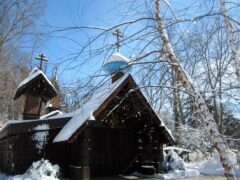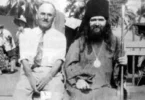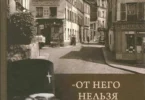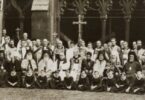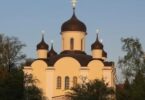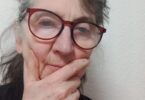On August 3, 2021, Protopresbyter Leonid Kishkovsky peacefully passed away in the presence of his beloved spouse Matushka Alexandra. He belonged to that pleiad of bi-cultural clergy who, while they were born or grew up in the diaspora, developed a keen knowledge of the past and present realities of the Russian Church. Fr. Leonid was ordained priest in 1969 and in 1974 he became the rector of the parish of the Kazan Icon of the Mother of God in Sea Cliff on Long Island. Since 1959, the headquarters of North American Metropolia and later the OCA have also been on Long Island in Syosset. As rector of the Our Lady of Kazan parish, Fr. Leonid began to work in the chancellery, having represented the OCA as “an ecclesiastical diplomat” for decades in various capacities.
Attitudes toward the Metropolia’s being granted autocephaly from the Moscow Patriarchate in 1970 further polarized the Russian émigré church community in North America.[1]We find a reference to this tense period in a diary entry by Fr. Alexander Schmemann for December 20, 1977: “Memorial service for Arseniev, yesterday, in the Karlovci church in Sea Cliff. There was … Continue reading
Although most of the parishioners of Our Lady of Kazan church left with Fr. Alexei Ionov in protest of a decision of the Metropolia, the ROCOR lost the suit over ownership of the parish in 1971.[2]On the trial, cf. Maria A. Jordan, “Reminiscences,” Historical Studies of the Russian Church Abroad. https://www.rocorstudies.org/2014/01/16/reminiscences-of-m-a-jordan.
This shared troubled past sets the historical backdrop for this interview. It was recorded on December 2, 2018. On this day, a group of Holy Trinity Seminary (HTS) graduate students from the class Russian Church Abroad: Its History and Identity (723) visited the Church of Our Lady of Kazan on a weekend field trip to the greater New York area.[3]A Student’s Travelogue: Three Day ROCOR History Field Trip to New York. Historical Studies of the Russian Church Abroad. … Continue reading Then-HTS professor Dr. Vitaly Permiakov also participated in the interview. I am grateful to Subdeacon Nicolas Mabin (London, UK) for the time he dedicated to transcribing this interview.
Deacon Andrei Psarev, August 5, 2021
Protopresbyter Leonid Kishkovsky Some Russian Orthodox came to settle here in the 1920s. Many started coming here (in a sense) for the traditional Russian “dacha” experience. They would live here permanently and would come. And at that time, when they went to church, they would drive either to Holy Trinity in East Meadow [NY], which already existed, or to St. Nicholas in Whitestone [NY], which already existed. Then, during the war [WWII], the story is that rationing was imposed, and it was harder to buy gasoline. And so, they started talking, “We should have a church here. There are quite a few of us here.” So that’s what happened. All of this land, the land on which the church stands, the parish hall next door, the rectory on the other side, and quite a bit of land around belonged to one person. His name was Boris Riaboff. He was a Russian man, an architect, who came, after the Russian Revolution, to the United States. So, he gave land and also a garage.
Matushka Alexandra Kishkovsky: This was 1942; this little garage that was made into a chapel.
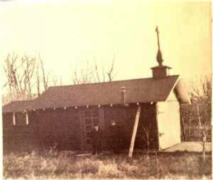
The church of our Lady of Kazan. Seaclif, 1942. Photo: https://ascenttomountsinai.wordpress.com/2018/01/28/strength-perfected-in-weakness-archpriest-alexi-ionov/
LK: That was first made into a chapel and the garage was where the main door is, sort of to the first pillar. It was tiny, tiny, tiny. Then, later in the 1940s, there was an expansion of the church, but it was smaller than this still. I believe that the back of the altar wall was somewhere here. Then, in 1969, and I happened to be here, having been ordained a deacon at St Vladimir’s Seminary, and then we came here for a Sunday liturgy and I saw the expansion being constructed. They moved the wall forward and lifted the ceiling, made it look more and more spacious, although it’s a tiny church of course, it can take about 200+ people. We had a wedding a few weeks ago with a large crowd coming; I think it may even have been 250 or so.
AK: No.
LK: No? You think less? Could be.
AK: There were at most 150 guests and not everybody came.
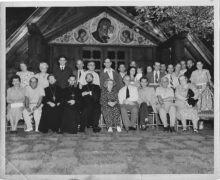
Left to right: Nina Berberova, Vladimir Terent’ev, Fr. Dmitrii Gisetti, Fr. Alexei Ionov. The second, on the right is Nicholas Arseniev. The second row on the left: Tatiana Terent’eva, next to her is Matushka Valentina Ionov. The second on the right in the second row is Fr. Alexander Kisiev and the fourth on the right in the same row is Matushka Kalista Kiselev. Photo: Sophia Kishkovsky, courtesy of Alex Terentiev
LK: OK. My mistake. But it felt like that. [laughter] Now in the beginning this was a Russian-speaking parish entirely, with services entirely in Slavonic. Well, it’s part of history. When autocephaly was granted by the Russian Orthodox Church [in 1970], this parish was split. Two-thirds of the parishioners objected to the autocephaly and they were not led really, but joined by the priest. His name was Father Alexei Ionov. And unfortunately, there was a long, painful and expensive court case for about five years. And in the end, the judge, upon examining documents and history, concluded that the parish was founded with the blessing of a particular Orthodox hierarchy. So, if the initial blessing was [from] Metropolitan Theophil [First Hierarch of American Metropolia in North America from 1934 to 1950], the question was who was his successor? And that was Metropolitan Leonty. Who was his successor? Metropolitan Irenei. And the judge ruled that hierarchical line determines the outcome, which is an interesting legal case. It’s in the law books, actually. [4]Regarding hierarchical and congregational distinctions in American parish by-laws see Fr. Daniel Franzen, “The Mayfield Parish, Congregationalism, and the American Orthodox Experience in the … Continue reading Not all states do it this way but this judgment is in this state’s laws, that’s the way it happened. And I was asked to come here. I was already a priest for about five years in San Francisco. I was asked to come here and so I did, and we have been here since 1974. I should mention Father Ionov: you may inadvertently know a lot about him. Do you know the film “Pop”? That’s him. It’s actually based on his life. So, that’s interesting.
AK: So, he was here for what – 24 years?
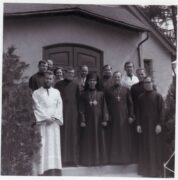
Left to right: J. McEachen, L. Kishkovsky, S. Beskid, C. Tarasar, D. Drillock, V. Litwinowicz, Bp. Theodosius of AK, O. Olas, Fr. A.Schmeman, ?A.? Feodoroff, S. Stojsavljevich, P. Kucynda. Photo: P. Scorer. Caption by Fr. John Tkachuk. Courtesy S. Kishkovsky
LK: He was here for a long time, yeah. As a seminarian, I used to visit Sea Сliff parish and meet with some young people here, and [with] Father Ionov, so he knew me pretty well. Also, he knew me because he replaced a priest in Los Angeles in the 1960s and I was an altar server and, anyway, I liked him a lot. When we arrived here under the tragic circumstances, Father Ionov had to vacate the priest’s house and he was still living in Glen Cove, so Matushka and I visited him. And I thought that was the right thing to do. At that time there was a very tense situation in the Orthodox community here. And interestingly, before he was moved by the ROCOR to California, he came to visit us as a kind of friendly visit. We can only imagine how painful it had to be for him but he did it. He died in California and was buried in Novo-Diveevo [NY] after otepevanie [a funeral] in St. Seraphim’s Church.
Now when I came, the Parish Council told me, “We need some English now.” And their proposal was to have an English liturgy, all in English, once a month and to have the other liturgies of the month entirely in Slavonic. And I simply said, “I won’t do it that way.” They wanted to know why. I said because, in the end, it will create two communities. It will create a group that will come only once a month and a group that comes a couple of times a month and it will split the community: you don’t need that. So since then, we have had mixed language. In the beginning, there was little English. That was in the 1970’s; now it is what? About 50 percent roughly on Sundays?
AK: That’s depending on who’s here.
LK: So, the language division depends on who is actually here. Evening Service is now very often simply in English because that’s who’s here — reading, singing, etc. So that does work. The profile of the community is certainly an Orthodox mosaic. There are Russians, there are people from Ukraine, from Belarus. There are a couple of Romanians, there is a Bulgarian family… Georgian… Japanese, no?
AK: No. Unfortunately, no I could deal with that… [chuckle]
Archpriest John Bartholomew (Assistant priest): There was actually, there was… What was their name? They were friends with…
LK: Yes. My memory is failing me. Oyama, right? Yeah, he was actually head of, I think, Japan Airlines in New York.
JB: I wasn’t coming here at that time. I’m not sure.
LK: He and his wife came here to church. And when I’d been in Japan, I would always meet him in Japan as well — lovely couple, now quite elderly. So, there is a mosaic. There are a few American converts, not least the assistant priest and the choir director. So, it’s an Orthodox mosaic, for sure. In the 1970’s, at least two-thirds of those who were parishioners lived nearby. The radius for them was Sea Cliff, Glen Head, Glenwood Landing, Locust Valley, Glen Cove. Now, at least two-thirds live at much greater distances. One woman, and she was in church today, usually she is, comes from Southampton. If you know the geography of Long Island, that’s a jump in a whole. There are those who come from Queens and Brooklyn.
AK: Just like St. Seraphim’s [a ROCOR parish in walking distance from this parish]
LK: Yeah, that’s what Father Seraphim [Gan, the rector of St. Seraphim’s parish in Sea Cliff] told us last night. Yeah! And so, the profile in that regard of the three parishes here, the two ROCOR parishes, Pokrov in Glen Cove, St. Seraphim’s in Sea Cliff, and Kazan in Sea Cliff. In that regard, there is a great similarity, which creates a different dynamic of parish life, of course. Several decades I discovered: if I need to have a Parish Council meeting, forget convening it on Friday night or Wednesday night. It has to be on Sunday after liturgy; that creates a different dynamic.
Matushka Doreen Bartholomew (Choir Director): Same thing with choir rehearsals now, it has to be on Sunday.
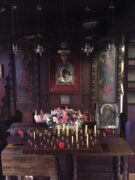 LK: Yeah. Well, we have to live with what we have. Later, I’ll invite you to take a look at the kiot on that side of the Kazan Icon: that’s an interesting historical connection. The donor was Elizabeth Shoumatoff. She was an artist, a portrait painter. She lived in Locust Valley. She came as a young woman after the [Russian] Revolution and had a talent and became a well-known portrait painter. One or two of her portraits of presidents are in the White House. But in a sense, more dramatically, she had a friend who had had a “relationship” with President Franklin Roosevelt, [laughter] which Eleanor Roosevelt discovered in the 1920’s and there was a big family scandal. But the lady was very wealthy and surreptitiously, although there was no affair any longer, she had a certain limited contact with Franklin Roosevelt. So, she, the friend, invited Shoumatoff to paint a portrait of Franklin Roosevelt, to do it in his southern home in Georgia. So, Shoumatoff is there in the house, painting, and the President is sitting at a table, a desk, working on some papers, and all of sudden he falls over: he died. So, she was present at the moment that President Franklin Roosevelt died. There was a need for her to get out quickly because she was not supposed to be there —I guess not on the official knowledge of the White House — and she never finished the portrait. If I recall, the unfinished portrait, the head, one shoulder, and one part of the torso were done. It’s quite an interesting story. Books about Franklin Roosevelt now contain a description of this. For many decades, there was no description at all but now books vividly contain the story. In one of the books I read, I guess on her testimony, that she was driving from Georgia to the north and stopped at a train crossing and saw the President: his casket was in a car with an honor guard and it was lit up. And so, she saw the President’s body on the train as they were heading to Washington and then to Hyde Park where the burial took place. So, I’m very grateful to Shoumatoff for the gift of the icon. It was a family icon, brought from Russia. Those who study history have to deal with painful episodes. The place where that icon is now was occupied for many years by a so-called Wrangel icon, which was a gift of the Wrangels. General Wrangel’s widow was a parishioner and for many years a President of the [Parish] committee. Her daughters were parishioners here, but, because they were on the anti-autocephaly side, when they had to leave this church, they took the icon with them. It is now in Novo-Diveevo.
LK: Yeah. Well, we have to live with what we have. Later, I’ll invite you to take a look at the kiot on that side of the Kazan Icon: that’s an interesting historical connection. The donor was Elizabeth Shoumatoff. She was an artist, a portrait painter. She lived in Locust Valley. She came as a young woman after the [Russian] Revolution and had a talent and became a well-known portrait painter. One or two of her portraits of presidents are in the White House. But in a sense, more dramatically, she had a friend who had had a “relationship” with President Franklin Roosevelt, [laughter] which Eleanor Roosevelt discovered in the 1920’s and there was a big family scandal. But the lady was very wealthy and surreptitiously, although there was no affair any longer, she had a certain limited contact with Franklin Roosevelt. So, she, the friend, invited Shoumatoff to paint a portrait of Franklin Roosevelt, to do it in his southern home in Georgia. So, Shoumatoff is there in the house, painting, and the President is sitting at a table, a desk, working on some papers, and all of sudden he falls over: he died. So, she was present at the moment that President Franklin Roosevelt died. There was a need for her to get out quickly because she was not supposed to be there —I guess not on the official knowledge of the White House — and she never finished the portrait. If I recall, the unfinished portrait, the head, one shoulder, and one part of the torso were done. It’s quite an interesting story. Books about Franklin Roosevelt now contain a description of this. For many decades, there was no description at all but now books vividly contain the story. In one of the books I read, I guess on her testimony, that she was driving from Georgia to the north and stopped at a train crossing and saw the President: his casket was in a car with an honor guard and it was lit up. And so, she saw the President’s body on the train as they were heading to Washington and then to Hyde Park where the burial took place. So, I’m very grateful to Shoumatoff for the gift of the icon. It was a family icon, brought from Russia. Those who study history have to deal with painful episodes. The place where that icon is now was occupied for many years by a so-called Wrangel icon, which was a gift of the Wrangels. General Wrangel’s widow was a parishioner and for many years a President of the [Parish] committee. Her daughters were parishioners here, but, because they were on the anti-autocephaly side, when they had to leave this church, they took the icon with them. It is now in Novo-Diveevo.
AP: We did see it; it is in the house-church there.
AK: And you said that we have [Saint] Peter and [Saint] Olga there?
LK: Oh… Yeah, the wood carvings for the icon — for those who don’t know the history, it’s a bit mysterious: why is it that the Apostle Peter and [Saint] Olga are carved in it? It’s because of General Wrangel and his wife: they are their [name] saints.
AP: So actually, the kiot itself was associated with that icon in Novo-Diveevo while the Kazan Icon of the Mother of God was donated by Shoumatoff. OK, now it makes sense.
LK: Well, given the history as it has unfolded in last decade [a point of reference the reconciliation that took place in the Russian Church in 2007], this is at this point “funny and amusing,” but when I was assigned by the Orthodox Church in America’s bishops to accompany one of our bishops to Moscow in 1978 — that was my first trip to the Soviet Union, to Moscow — and one evening the phone rings and it’s Elena Petrovna Wrangel, and she was a very imperious lady, and so on the phone she begins to berate me, asking questions. “Is it true, Father, that you’re going to Moscow?” “Well, you shouldn’t go. It’s wrong to go. It is completely inappropriate.” OK. So, I listened. This is my first trip and I can only guess what’s going to happen on the trip but it will be all Church stuff, obviously. It was a Church anniversary there in Moscow. Then she wanted to know if I would be meeting with Metropolitan Nikodim of Leningrad. So, I said, “Yes, Elena Petrovna, from what I know it’s quite inevitable that I will meet Metropolitan Nikodim, because he is the Head of the Foreign Department of the Moscow Patriarchate.” “But that’s not only wrong, that’s immoral.” [She] went on and on. Then she said, “I know for sure that he is a major general of the KGB.” and it went on and on, and then she paused, she ran out of steam, and then I said, “Elena Petrovna. I’m beginning to think you’re in the KGB.” [laughter] Then she paused. “How dare you? (Kak Vy smeete!) “Elena Petrovna, I think probably only those who are in the KGB know for sure who is a major general in the KGB.” [Laughter] So, I have to say she had a sense of humor. She laughed and that was actually the beginning of a personally perfectly good relationship.
AP: You won her over. Otets [Father] Leonid, can you talk to us about your lifelong relationship with the Russian Church Abroad? So, I mean, I understand what you were disclosing and describing: it was kind of was painful at times, but this would be always helpful for the record.
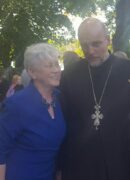
Matushka Alexandra and the rector of St. Seraphim parish, Archpriest Seraphim Gan. Photo: Lora Jakowlew
LK: Well, it was painful in principle. But here we established from the beginning of our life here, I would say, a close and friendly relationship. So, for example, upon arrival here in Sea Cliff, I went, not only to visit Father Ionov here, with my wife, but I went to visit the then Father Mitrophan [Znosko-Borovskii, a rector of the ROCOR parish and later a bishop, 1909-2002] in Glen Cove. Probably the relationship was helped by the fact that he came from Poland. So, he knew — not well —but he knew my grandfather, who was a priest in Poland and, like him, my grandfather was a priest also with immigrant refugees in Germany. So, on that basis in part, we had a perfectly good relationship at a time when many people looked at it, certainly in the Zarubezhnaia Tserkov’ [Russian Church Abroad] looked at that negatively. I think Father Mitrophan took some criticism. Well, on the other hand, of course here people were also for a time aggressive. So, when Father Ionov died in California, and his brother-in-law informed me immediately, I at the end of the liturgy said “Father Alexei has passed away. I know that the history has been painful, but he married many of you; he baptized many of you; it is time for us to pray for the repose of the soul of the new departed otets Alexei, and, well, I had two or three somewhat loud parishioners who began publicly objecting that we shouldn’t do that. His body was brought here for the otepvanie and of course, we went to the otpevanie and we offered but also learned that they already had the plan to drive by this church where he had served 25 years. And from St. Seraphim’s it was going to go to Novo-Diveevo for burial, but they would drive by here. So, I remember absolutely agreeing. My wife and I agreed that we would open the door to the church, so, when the hearse drives by, the door would be open, and then… My wife’s name is Mimi popularly; you might not want to put it on the ROCOR [webs]site… [laughter]
AP: Why not?
LK: Alexandra Feodorovna, of course. She insisted that the candles had to be lit in the church. I said, “The hearse will be in front of the church for about 5 seconds. I don’t really see the need, but so I stayed at Saint Seraphim’s, and Mimi came here and opened the door and lit the candles and the lampada [oil lamps in front of icons]. And so, the hearse drives by. And a week or two later, we got a lovely letter from Father Alexei Ionov’s daughter who wrote that the last years in this church for the family were very tragic and painful and there was a heavy burden on her heart, and that driving in front of the church, and to see the doors open and the lampada and the candles lit, that it lifted the burden from her heart. So, I was impressed by my wife’s wisdom.
At some point Father Mitrophan agreed — our two small daughters — [that] we were not going to start a Russian school at a time where there was a perfectly good Russian school at St. Seraphim’s. So, my wife and I asked him if could we send our daughters to the Russian school. And so he absolutely agreed and a few other children from this parish went to the Russian school at St. Seraphim’s. At one point a bit later, Father Mitrophan asked Matushka to be the head of the parents’ group, I guess – right? In a manner of speaking, at the school. So, he was pushing in that direction and I was pushing in that direction over relationships as well.
AK: And also, I remember Father Mitrophan, when we visited him that first week we came, he knew your aunts and uncles were…
LK: …were all in Zarubezhnaia Tserkov’.
AK: …were all in Zarubezhnaia Tserkov’. He absolutely stated and said “Let bygones be bygones” and he wanted a new chapter.
JB: I want to raise my hand for a bit. One thing Bishop Mitrophan told me, when I was technically in the OCA but went to Saint Seraphim’s for various reasons, Bishop Mitrophan said, “Are you going to be here on Pascha?” And I said, “Yes.” He asked are you going to receive communion here. And I said. “I am the OCA. We are not in communion.” He said in Russian (I won’t reproduce the Russian) that politics stops [at] the chalice, that politics don’t go as far to the chalice. I remember that all my life.
LK: Yeah, it’s memorable.
AP: Was this in the 1980s?
JB: 1990’s, probably.
LK: At that time, we could go to services there but certainly couldn’t concelebrate or receive. When the reconciliation of the ROCOR with the Russian Orthodox Church of Moscow occurred, I think the greatest achievement was the Eucharistic communion. So, priests from the other two parishes have come here for feasts and concelebrated with us; deacons have come and I have gone there to St. Seraphim’s and to Pokrov. I think the fact that we are, in that regard, in one and the same Church eucharistically is really a great spiritual achievement of the last 10 years.
Dr. Vitaly Permiakov: Did this concelebration start right away? Because I remember there was some sort of a commission, working out sort of between OCA and ROCOR…
LK: That was about other issues and problems. Concelebration occurred immediately including… I received invitations to concelebrate at the [ROCOR] cathedral on 93rd street. As to the cathedral, at that time the most active person in that direction was actually Bishop Jerome: he reached out, he sent emails. Father [Alexei] Ohotin, the late Father Ohotin from Flushing, at one point….
AK: He grew up in this parish.
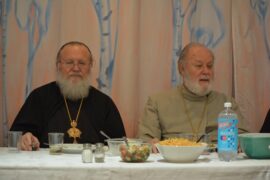
Metropolitan Hilarion and Fr. Leonid at the Holy Virgin Protection and St. Sergius Church in Glen Cove, NY
LK: He grew up in this parish. He is from this parish. And until her death, his sister was here. But he showed up one time when we were having a service here with Metropolitan Jonah and I think maybe at least one priest from the ROCOR was here, and we walked out and there is Father Alexei, and so I said something welcoming. “You’re welcome and, please, come next time and concelebrate.” And he said something, I think to Metropolitan Jonah [The First Hierarch of the OCA from 2008 to 2012], that he can’t ever come on the principle that we are on the new calendar and he’s on the old calendar. Then, I was at the ROCOR cathedral by invitation of the Metropolitan (and I can’t remember what stage that was). Was Metropolitan Lavr still living? I can’t remember. But I was invited by the Metropolitan through Bishop Jerome, and I was vested, Father Ohotin came into the sanctuary, saw that I was vested [chuckle] and he came up to me, kind of grinned, and said, “Well, I guess we have to concelebrate.” [laughter] So I said, “Well, I guess it’s blessed by the Metropolitan and I think by God too.”
When the rather well-known Russian philosopher, [Nicholas] Arseniev died [in 1977] —he lived in Sea Cliff — and the funeral services were at St. Seraphim’s. He kind of split his time a little bit between the parishes. So, of course, I went to the funeral and, since a number of our priests in the Metropolia (OCA) were his students, I made some phone calls and about eight priests came for the panikhida at St. Seraphim’s, including a student of Arseniev by the name of Metropolitan Theodosius [The First Hierarch of the OCA from 1978 to 2002] and Father [Alexander] Schmemann. So, we were present at the panikhida. And I went to the otpevanie on the next day. And Father Mitrophan, on the way to the cemetery, gave me an epitrachelion and censer and said, “You will put the body or the casket into the grave.” So, I did that. A couple of days later, Father Mitrophan received a very strict letter from, I guess, from Metropolitan Philaret, which, point by point, described what had happened: that you welcomed an OCA priest; you censed Metropolitan Theodosius as a bishop; you invited Father Alexander Schmemann to preach, (which happened); and after the otpevanie you invited Father Khishkovsky to inter the body. And he was severely criticized in the letter, reprimanded, which, well, it’s sad that that was the state of affairs but that’s where it was. We have gone beyond that, certainly.
AP: Thank God for this.
LK [addressing to the audience]: Do you have any perspectives you want to share or any questions that come to mind?
Monk Theodore (Stanway): I have a question, not really related to the subject we’re discussing. I am particularly in love with the architecture and interior of this church. Were there any influences apart from the developers?
LK: The architect: the man who owned the land, gave the land and the garage and all that — he was an architect and the concept in every detail was his concept. I am told that in his family background there was some linkage to starovery [Old Believers] in Russia. So, that is quite interesting. His life and biography have now been explored in Russian publications, including, I think, in an online dictionary of architecture a pretty good article about him. Among the icons — we need some repairs done, some restoration, — but the Cross and the two icons on either side of the Cross probably are painted by Pimen Sofronov. And for sure, the two icons of the Christ and the Mother of God and the iconostasis are painted by Sofronov with one caveat: the originals are stored away because they began to get damaged by humidity, etc. and these are actually photos but several times I had a restoration done on the originals by a very well-known restorer who has since died [2012]?. The woman from Russia. And the last time I sent them to her, she essentially refused…
AP: Xenia Pokrovskaia?
LK: Yes. Last time I sent here an icon she refused because she said that the condition of the icon is such that in a very short time it will begin to deteriorate.
AK: Because we don’t keep the permanent temperature here in the church.
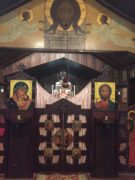 LK: So, I agitated the Parish Council to agree to have it restored but to send the icons, as she suggested, [Pokrovskaia] to a museum of icons in Russia [Rublyov Museum of Early Russian Culture & Art] because she considered those two to be real classics of iconography and that, in her mind, it would have been good to share it in the Russian context of the emigration icon. But she said that they’re classical iconography but very poor materials. And the fact that the materials are poor contributed to the deterioration. Anything I’m missing, Father John? Ah! Yes! The deesis is interesting also. That wall was empty. There was no iconography there when we came in 1974 but we had a sketch from Boris Riaboff’s hand that indicated how it should look and who should be on it. And I discovered at that time Kyrill Katkov in New York was a very good iconographer. He was actually the brother of, I think, Elena Meyendorff’s mother.
LK: So, I agitated the Parish Council to agree to have it restored but to send the icons, as she suggested, [Pokrovskaia] to a museum of icons in Russia [Rublyov Museum of Early Russian Culture & Art] because she considered those two to be real classics of iconography and that, in her mind, it would have been good to share it in the Russian context of the emigration icon. But she said that they’re classical iconography but very poor materials. And the fact that the materials are poor contributed to the deterioration. Anything I’m missing, Father John? Ah! Yes! The deesis is interesting also. That wall was empty. There was no iconography there when we came in 1974 but we had a sketch from Boris Riaboff’s hand that indicated how it should look and who should be on it. And I discovered at that time Kyrill Katkov in New York was a very good iconographer. He was actually the brother of, I think, Elena Meyendorff’s mother.
AP: I just saw his iconostasis in St. Peter and Paul in Montreal a few days ago, painted by Nikolai Shelikhoff, and it’s kind of fine with me, but some other people who saw photos they were totally taken away, that it was the best of the best.
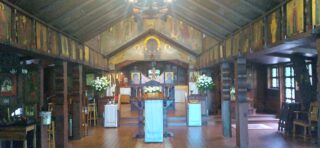 LK: So, I contacted him, asking him to give us an estimate of what it would be. And he postponed and postponed and finally I got him to tell me that he didn’t like to paint for churches because you can never get the money that you need and so on. So, in the end, I mean it was measured for him, we gave him the measurements; he gave us the estimate. The estimate was $1000 per figure which, at that time, seemed like a lot but actually is not very much. We put panels up, screwed them into the wall, and then took the panels back down, [and] took them to his studio in New York. He did the iconography. Then the panels were brought back, screwed into the wall, and then he came and worked for about a day to cover the seams and also the holes where the screws have gone in. Now, when I was in Prague — you’ve been in Prague maybe?
LK: So, I contacted him, asking him to give us an estimate of what it would be. And he postponed and postponed and finally I got him to tell me that he didn’t like to paint for churches because you can never get the money that you need and so on. So, in the end, I mean it was measured for him, we gave him the measurements; he gave us the estimate. The estimate was $1000 per figure which, at that time, seemed like a lot but actually is not very much. We put panels up, screwed them into the wall, and then took the panels back down, [and] took them to his studio in New York. He did the iconography. Then the panels were brought back, screwed into the wall, and then he came and worked for about a day to cover the seams and also the holes where the screws have gone in. Now, when I was in Prague — you’ve been in Prague maybe?
AP: Just briefly.
LK: In Prague, if you go to the Olšany cemetery, which is a Russian Orthodox cemetery, there’s a chapel. It’s not tiny but it’s a small chapel and I was accompanying, I guess, Metropolitan Theodosius. The priest there said, “We think the artist who painted the icons is Kirill Katkov but we don’t know.” I said, “I can tell you that it was Katkov because he told me himself that it was him. It was the first commission he had ever to paint icons and he painted the iconostasis in that church. That priest is now the Archbishop of Prague.
VP: So, Sofronov probably worked on this here?
LK: This is I don’t know.
LK: There was an exhibit, Ohio or somewhere, about half a year ago. I don’t know much about it, but I spoke briefly with the woman who put it together.
VP: This is in the 1940s? Or when was it painted?
LK: Probably 1950’s. Now one item that isn’t here is at Jordanville. There above the baptismal font we have a contraption which usually has a framed military banner from Russia with an icon of Christ on it, and the director of the Historical Museum of Jordanville Michael Perekrestov saw it on some visit here and asked me if it could be lent for the exhibit, and it’s there now. So, we agreed to do that.
AK: So, I think you can say that a part of you is at Jordanville cemetery?
LK: Oh yeah, my grandmother is buried at the Jordanville cemetery, my aunt is buried there, my uncle is buried there and my aunt’s husband.
AK: And your uncle was a ROCOR choir director in Los Angeles and he was also called Leonid Khishkovsky and…
LK: The people first assumed that I had good musical stuff.
AK: He was musical and you were not. [laugher]
AP: And [your] father himself, he came at this time from California to the East Coast, right?
LK: Yeah.
AP: OK, so he probably was in ROCOR yourself while you were in California?
LK: No, from the beginning my mother and father… Well, we lived next door — as refugees arrived from Germany in 1951 — we lived next door to Bogorodichnyi khram [Church of the Mother of God] which was Metropolia.
AK: You were sponsored…
LK: Archbishop John (Shahovskoy) was very active in securing sponsors for the refugees.
AP: On Argyle in Los Angeles, is that the same Protection Church?
LK: No, Argyle was a ROCOR rebellion against ROCOR.
AP: Right. [laughter]
LK: My uncle was a choir director there. But I grew up in the Holy Virgin Mary Cathedral in Los Angeles; we lived next door to it. I don’t know what was happening; I was a child of 8/9/10 years old. My mother and father with me were going next door. My grandmother and aunt and uncle, even without a car, were traipsing across Los Angeles to the Fountain Avenue church – Transfiguration [ROCOR]. So there was something in the mentality, I don’t know. I think [for] my parents, it was “Well, we’re living next door to the church; that’s where we’re going.” [laughter]
AK: … we lived next door but that’s not where we going. [laughter. An allusion to the famous joke that a Russian abroad always needs two churches to go to the one and not to go the other.]
LK: …But we were a family of split jurisdiction. I was an altar server, subdeacon, and was sent to seminary, Saint Vladimir’s, from the Metropolia parish in LA. Somewhat later, I discovered… My father died when I was 18, exactly on my birthday. He was buried from that church. The priest there became very significant in my life, Father Dmitri Gisetti, and he was instrumental in getting me to seminary. Later, I discovered that he was the first cousin of Patriarch Alexei [II] of Moscow. So, when, in the 1990’s, I was often in Russia, in Moscow, and in other places of the world, actually, where we’d meet Metropolitan Alexei (and later Patriarch), it seemed we had some special relationship somehow. But actually, in that first time in Moscow, I was assigned by the organizers to be a priest vested for the panikhida at the malyi sobor Donskogo monastyria [Small Donskoi Cathedral] where the grave of Patriarch Tikhon was. And I remember, we arrived on time; I think they chose priests from the dioceses where Patriarch Tikhon had served as a bishop, so I was the American. And we were vested, we were waiting interminably, nothing was starting. Then a metropolitan entered — it was Alexei. He didn’t know me at that time. So, he vested and stood in front of the altar and we were still waiting for the Patriarch to arrive — Patriarch Pimen. And so, I came, got his blessing, and introduced myself, simply so he knew my name, where I’m from, and then said that for me Father Dmitri Gisetti in Los Angeles was a second father. Now, he knew that I was speaking of his first cousin. He knew that I knew but he didn’t even blink. He was standing in front of the altar, absolutely silent. I suppose, well, it was 1978. In the end, who was I? He didn’t know. Was I some kind of provocation and so on and so forth? So, for me it was a lasting image: not that he is a bad man but, rather, what terrible circumstances he and others lived in, which is memorable.
AP: Was it when Saint Tikhon’s relics were transferred [from an outside grave to a crypt within the church]? Was it in that time?
LK: No, that happened in the 1990s… 1989 or 1990. So, history marches on. Right now, it marches to the drumbeat of breaking of eucharistic communion [between Moscow and Constantinople] which is very sad.
References
| ↵1 | We find a reference to this tense period in a diary entry by Fr. Alexander Schmemann for December 20, 1977: “Memorial service for Arseniev, yesterday, in the Karlovci church in Sea Cliff. There was a whole group of us ‘American’ priests headed by Metropolitan Theodosius. Unexpectedly for me, Fr. Mitrofan Znosko asked me to give a sermon at the end of the memorial service. Just think – the same Fr. M[itrophan] who just seven years ago served demonstrative memorial services for the martyrs in front of the gate of the Syosset residence! Whose parishioners painted red hammers and sickles on these gates… Indeed everything passes away…” (Archpriest Aleksandr Schmemann, Dnevniki [Journals] 1973-1983 [Moscow, 2005], 404.) |
|---|---|
| ↵2 | On the trial, cf. Maria A. Jordan, “Reminiscences,” Historical Studies of the Russian Church Abroad. https://www.rocorstudies.org/2014/01/16/reminiscences-of-m-a-jordan. |
| ↵3 | A Student’s Travelogue: Three Day ROCOR History Field Trip to New York. Historical Studies of the Russian Church Abroad. https://www.rocorstudies.org/2018/12/03/a-three-day-rocor-history-field-trip-to-new-york/. |
| ↵4 | Regarding hierarchical and congregational distinctions in American parish by-laws see Fr. Daniel Franzen, “The Mayfield Parish, Congregationalism, and the American Orthodox Experience in the Twentieth Century” https://www.rocorstudies.org/2020/06/24/the-mayfield-parish-congregationalism-and-the-american-orthodox-experience-in-the-twentieth-century/ |

